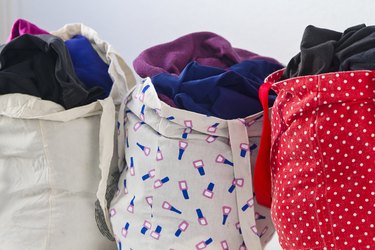
With increasing awareness of the effect microplastics have on the environment, companies that produce high-performance outdoor gear with synthetic material, like Patagonia, are encouraging their customers to use special baggies when following their washing instructions to avoid further contamination.
Washing Patagonia Fleece
Video of the Day
These baggies are designed to allow water and detergent to pass through but not the tiny threads of plastic the garments shed as they are washed.
Video of the Day
In fact, a synthetic fleece jacket can release as many as a million plastic microfibers per wash. Patagonia stands out as one of the few outdoor garment manufacturers who have actively studied the impact on the environment in this way and have attempted to ameliorate it by drawing more and more of its synthetic materials from recycled plastics.
This doesn't reduce the number of plastic microfibers being delivered to the water systems by washing a synthetic fleece, but it does delay the plastic's arrival in the ecosystem by tying it up in garments first. To reduce the amount of microplastic you personally contribute to the waterways, you can take a few approaches in your laundry routine.
Patagonia Baggies Washing Instructions

Filtering garment bags can help capture those microfibers before they enter the watershed, but what do you do with these fibers once you've caught them in your filter bag?
One suggestion involves putting it in a tightly sealed container and putting it in the trash along with your dryer lint. This will do the most to prevent the plastics from entering the watershed, further delaying the plastic from entering the overall ecosystem. Beyond that, a few other small life changes can further lower your plastic footprint. Use liquid laundry detergent and fill your washing machine as much as possible for each wash to reduce friction, which is the leading cause of a garment shedding microfibers.
Wash your clothes with low-temperature water on a gentler cycle than you might use otherwise to reduce fiber shedding. Using fabric softener has been shown to reduce a garment's waterproofing, but it also reduces the number of microfibers shed per wash, so find your own balance with that. Air dry your laundry when possible.
Larger-Scale Approaches
Front-loading washers and dryers have been shown to result in less synthetic microfiber shedding than top-loading models, potentially due to the lack of a central agitator component.
You can install a microfiber filter on your washing machine to catch the vast majority of synthetic microfibers. At roughly $60 per filter cartridge, it's worth considering that there is doubt as to the sustainability and effectiveness of this approach.

Older synthetic fleeces have been shown to shed more than newer ones, so buying newer synthetic fleeces and using natural fleeces for longer are obvious contributions, though this is not always practical depending on your lifestyle. In all, it's important to acknowledge that on a large scale, each individual's small plastic footprint can add up to a significant amount of pollution, but the vast majority of the global problem is due to the action or inaction of massive corporations. That said, it doesn't hurt to acknowledge what you can do and make an effort to be a part of the solution.
- Patagonia: Product Care
- The Gear Caster: Wash Your Fleece Without Polluting
- Outside: A Closer Look at the PR Feud Between Liberty Oilfield and the North Face
- Patagonia: What We’re Doing About Our Plastic Problem
- Sierra Magazine: How to Handle Microbeads
- Friends of the Earth: Microfibres: The Plastic in our Clothes
- PlanetCare: The Most Efficient Washing Machine Filter Ever Designed
- BBC: Washing Machines' Microplastic Filters 'Untested'